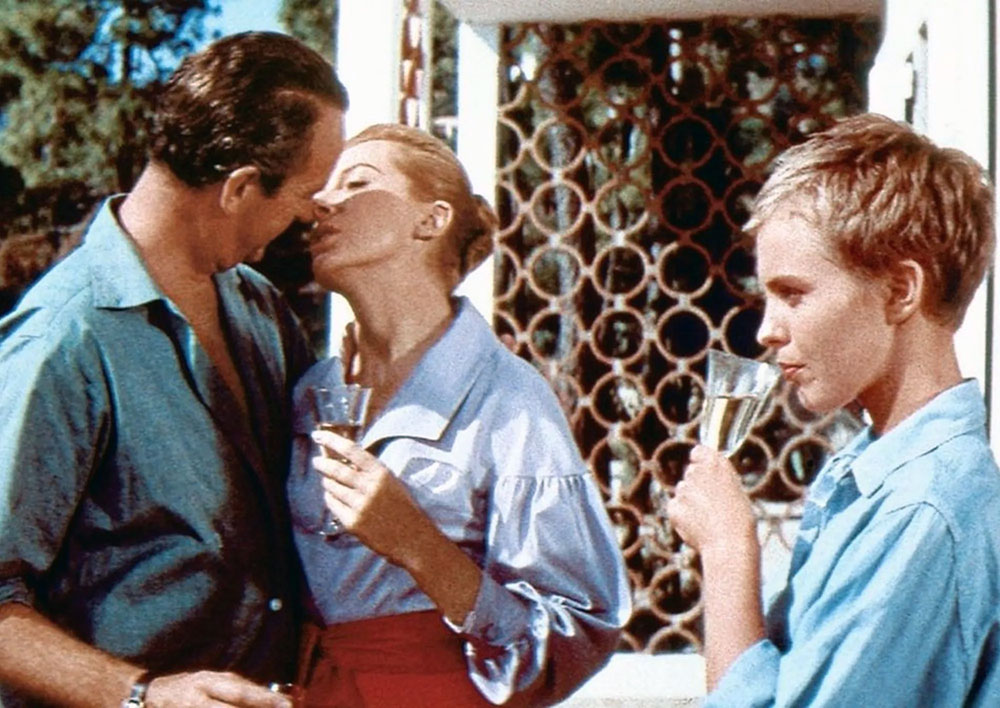In 1954, the French teenager Françoise Sagan released her coming-of-age novel Bonjour Tristesse to lukewarm critical reception; four years later, it was adapted in Technicolor and CinemaScope by Otto Preminger. A Hollywood extravaganza seems like an odd fit for a French family drama: it is a British-American co-production starring a young American actress who would, ironically, become the face of the French New Wave. But somehow, the theatrical style and sumptuous costume design perfectly communicate this intimate story about the perils of being a teenage girl.
The cast is so perfect it’s almost unbelievable: Jean Seberg as Cecile; David Niven as her playboy father, Raymond; and Deborah Kerr as Anne, the refined best friend of Raymond’s widow. There is an aspirational quality to Cecile’s life before Anne arrives. She vacations on the French Riviera with her doting father, entertaining his wealthy older friends and breaking the hearts of various unimportant boys her age. But in flashback we find that Cecile’s idealized life of the previous summer has been replaced by malaise and melancholy. Even spontaneity becomes routine after a while.
Cecile’s narration, taken from Sagan’s novel, frames the film retrospectively. The present day is shot in black and white and the past in lurid color: the ocean an unreal blue, the bathing suits and summer outfits all shades of red, white, and yellow. The contrast between 17-year-old Cecile’s primary-hued world and 18-year-old Cecile’s monochrome emphasizes the intensity of feeling at that age.
The conflict of Bonjour Tristesse is rooted in the psychoanalytic theory that was popular at the time. David Niven is charming, smarmy, and irresponsible, a young person’s idea of the perfect parent. He and Seberg have lots of father-daughter chemistry, but she never seems jealous of her father’s revolving door of young women. Instead, she views them as short-lived set pieces to add variety to her and Raymond’s insular life. It’s not until Anne arrives that Cecile begins to feel threatened and replaced.
Kerr swoops in as a formidable mother substitute, and unlike Raymond’s other suitors, she’s age-appropriate, career-driven, and principled. The scenes between her and Seberg are touching despite the histrionics—it’s really quite progressive that she isn’t portrayed as the quintessential evil stepmother. Bonjour Tristesse is a spectacle film with beautiful sets and costumes, but it’s also an internal crisis of adolescent ego.
It would have been very easy for a director to belittle Cecile’s poor-little-rich-girl plight, but Preminger lends gravity to the subject matter. The film doesn’t laugh at its protagonist, but instead draws us into her world and encourages us to submit to mercurial teenage feelings. A good adaptation should feel tonally faithful while also existing as its own text. Bonjour Tristesse works because it keeps Sagan’s words at the center. The movie and the novel were probably integral to making me an annoying 16-year-old Francophile, but rewatching it as an adult, the real tragedy is that in Sagan’s world no one ever really grows up.
Bonjour Tristesse screens tonight, January 9, at Roxy Cinema, presented by Claire Donato.



